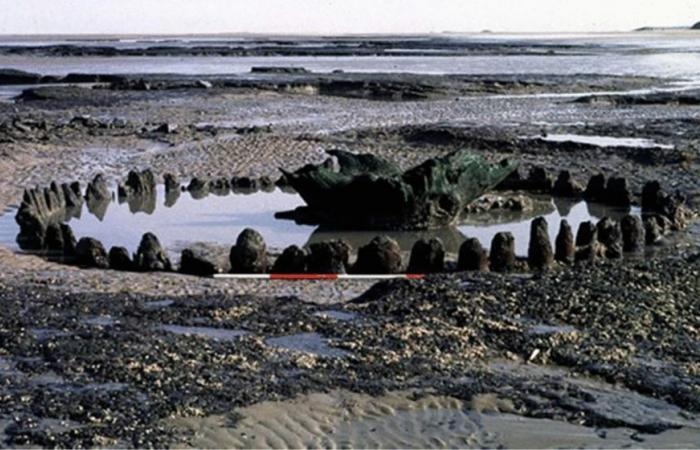One summer morning in 1998, the sea receded at Holme-next-the-Sea, on a beach in Norfolk in the east of England, and revealed Seahenge, the coastal counterpart of Stonehenge from which it is separated by 250 kilometers. However, since its discovery, this structure erected two millennia before our era and around a few hundred years after Stonehenge, which is also nicknamed Holme I, has raised more questions than it provides answers. At least, that was the case until today. Indeed, with his study published in the Geojournal, a researcher from the University of Aberdeen (Scotland) intended to unravel the mysteries of this monument from the early Bronze Age with obscure objectives.
Seahenge: a monument that has intrigued archaeologists for years
Ce circular monument measuring six meters by seven meters erected in what was then a salt marsh sheltered from the tides thanks to sand dunes and mud banks consists of an inverted oak stump surrounded by 55 split oak posts. And although the structure now barely rises above the water, this was not the case when it was built. Indeed, analyzes have revealed that the posts which form this tight palisade enclosure could protrude two to three meters from the ground. At its heart, the oak stump, stripped of its roots and bark, was around 250 to 350 years old when it was felled to build Seahenge. However, the monument itself dates from 2049 BCE.
For a long time, archaeologists assumed that Holme I and Holme II, another construction dating from the same period located a hundred meters further, were erected to mark the death of an important warrior or local chief. It was also suggested that these places were used during heavenly funeral during which the remains were left in the open air, thus exposed to the attacks of scavengers. However, these interpretations could not have been more uncertain. To get to the bottom of the story, Dr David Nance, the archaeologist at the University of Aberdeen who led the study, decided to rely on both climatic and environmental data than on astronomical and biological evidence, regional folklore and toponymy.
Seahenge: a response to climate change and the challenges of the times
Using this approach, Dr. David Nance was able to shed new light on these intriguing structures. “ We know that the period in which they were built 4,000 years ago was a prolonged period of falling atmospheric temperatures, harsh winters, and late springs that strained early coastal societies “, he explains. Because of this sharp deterioration of the climate at the time, populations across Europe and Asia were indeed suffering failed harvests and famineseven to the point of leading certain civilizations to their early ruin.
In this region of England, the builders may then have decided to resort to magic and religion in the hope of seeing the situation improve, with two monuments. “ It seems very likely that these monuments had the common purpose of put an end to this existential threatbut that they had different functions », nuances the researcher.
Holme I
« Dendrochronological data shows that the woods were felled in the spring of 2049 BCE “, explains Dr. David Nance. The scientist therefore thinks that the monument could have been erected with a simple ritual objective: extend the summer and make the weather milder. To support this thesis, he explains that “ The summer solstice was the date on which, according to local folklore, the cuckoo, which symbolizes fertility, traditionally stopped singing. He was returning to the Other World and summer was leaving with him. […] The shape of the monument appears to imitate the supposed winter dwellings of the cuckoo mentioned in folklore. A hollow tree or ‘the cradles of the Other World’ “. Here, the upturned oak stump could thus precisely symbolize this “cradle of the Other World”.
Holme II
Very comparable to the first, but with more imposing dimensions, this closed oval structure of 13.2 m in diameter is made up of central trunks oriented from northeast to southwest which appear to have been cut to accommodate an object, potentially a stretcher or coffin as part of a ritual use for mortuary purposes. According to the researcher, this monument was linked to the Samhaim celebrations, which have now given way to Halloween. “ Evidence suggests that they [des rois sacrés mentionnés dans les légendes de l’Âge du fer en Irlande et au nord de la Grande-Bretagne, NDLR] were ritually sacrificed every eight years. This had to appease the goddess Venus and ensure the well-being of the community », Explains the researcher.
These eight-year cycles indeed coincide both with the astronomical calendar and with the beliefs of the time, thus reinforcing the idea that these two structures indeed had a ritual objective linked to climatic conditions and the fertility of the earth.
Thus, the discovery of Seahenge and its archaeological mysteries continues to fascinate and intrigue. Thanks to the extensive research of Dr. David Nance and a multidisciplinary approach integrating climatic, environmental, astronomical and folkloric data, we now have a clearer view of the motivations and practices of the builders of this enigmatic structure. In response to the climatic challenges and existential threats of their time, these ancient inhabitants may have erected Seahenge and Holme II as ritual monuments to appease natural and divine forces. This interpretation reinforces the importance of archaeological sites like Seahenge in our understanding of ancient cultures and their complex relationship with their environments. As science continues to illuminate the secrets of the past, these remains remain a poignant testament to human ingenuity and resilience in the face of adversity.
Furthermore, the actual location of Seahenge may not be insignificant. Researchers believe that the proximity to the sea and the tidal cycles played a strong symbolic role in the design of this monument. The coming and going of water, associated with notions of renewal and transition between worlds, could have reinforced the sacred character of the site. The sea, perceived as both a source of life and destruction, would thus have represented a link between the living and the beyond, a passage between the material and spiritual world that the builders perhaps sought to master through their rituals.
Find the study here and the press release from the University of Aberdeen on this link.






